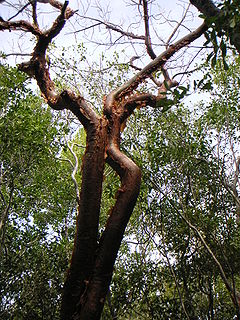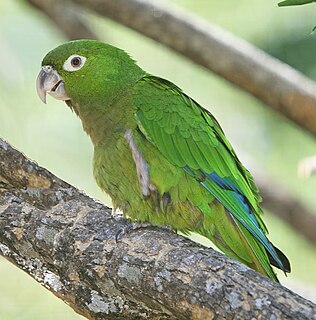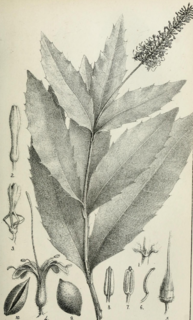
The Burseraceae are a moderate-sized family of 17-19 genera and about 540 species of flowering plants. The actual numbers differ according to the time period in which a given source is written describing this family. The Burseraceae are also known as the torchwood family, the frankincense and myrrh family, or simply the incense tree family. The family includes both trees and shrubs, and is native to tropical regions of Africa, Asia. Australasia, and the Americas.

Bursera graveolens, known in Spanish as palo santo, is a wild tree native from the Yucatán Peninsula to Peru and Venezuela.

Bursera simaruba, commonly known as gumbo-limbo, copperwood, chaca, West Indian birch, naked Indian and turpentine tree, is a tree species in the family Burseraceae, native to tropical regions of the Americas from South Florida to Mexico and the Caribbean to Brazil, Jinotega and Venezuela. Bursera simaruba is prevalent in the Petenes mangroves ecoregion of the Yucatán, where it is a subdominant plant species to mangroves.

Varronia rupicola, synonym Cordia rupicola, commonly known as the Puerto Rico manjack, is a critically endangered species of flowering shrub in the borage family, Boraginaceae, that is native to the islands of Puerto Rico and Anegada.

The olive-throated parakeet, also known as the olive-throated conure in aviculture, is a species of parrot in the family Psittacidae. It is found in forest and woodland in Jamaica, Mexico and Central America, and has been introduced to Hispaniola, in the Dominican Republic.
Bursera aromatica is a species of plant in the Burseraceae family. It is endemic to Jamaica.
Bursera lunanii is a species of plant in the Burseraceae family. It is endemic to Jamaica and listed as "near threatened."
Bursera malacophylla is a species of plant in the Burseraceae family. It is endemic to Ecuador, found only in the Galápagos Islands, and listed as "vulnerable."
Bursera tonkinensis is a species of plant in the Burseraceae family. It is endemic to Vietnam and listed as "vulnerable."
Canarium fuscocalycinum is a tree of Borneo in the incense tree family Burseraceae. The specific epithet fuscocalycinum is from the Latin meaning "dark calyx".
Canarium patentinervium is a tree of tropical Asia in the incense tree family Burseraceae. The specific epithet patentinervium is from the Latin meaning "spreading nerves", referring to the leaf veins.
Canarium pseudopimela is a tree of Borneo in the incense tree family Burseraceae. The specific epithet pseudopimela is from the Latin meaning "false pimela", referring to the species' resemblance to Canarium pimela.
Canarium sarawakanum is a tree of Borneo in the incense tree family Burseraceae. The specific epithet sarawakanum is from the Latin, referring to the species being native to Sarawak.
Protium attenuatum is a species of plant in the Burseraceae family. It is found in Dominica, Guadeloupe, Jamaica, Martinique, Saint Kitts and Nevis, Saint Lucia, and Saint Vincent and the Grenadines.

Bursera microphylla, known by the common name elephant tree in English or 'torote' in Spanish, is a tree in genus Bursera. It grows into a distinctive sculptural form, with a thickened, water-storing or caudiciform trunk. It is found in the southwestern United States and northwestern Mexico.

Bursera fagaroides is a species of flowering plant in the genus Bursera known by the common names torchwood copal and fragrant bursera. It is widespread across much of Mexico from Sonora to Oaxaca, and its range extends just into Arizona in the United States, although some sources suggest that it may now be extirpated in Arizona.

Opuntia chlorotica is a species of plant in the family Cactaceae. It is a species of prickly pear native to the southwestern United States and northern Mexico. Its common names include pancake prickly pear, flapjack prickly pear and dollarjoint prickly pear.

Dacryodes rostrata is a tree in the family Burseraceae. The specific epithet rostrata is from the Latin meaning "beaked", referring to the narrow-tipped leaves.

Bursera penicillata is a Mexican species of trees in the frankincense family in the soapwood order. It is widespread in much of Mexico from Sonora and Chihuahua to Oaxaca and Veracruz.

Macadamia ternifolia is a tree in the flowering plant family Proteaceae, native to Queensland in Australia, and is listed as vulnerable under the EPBC Act.











